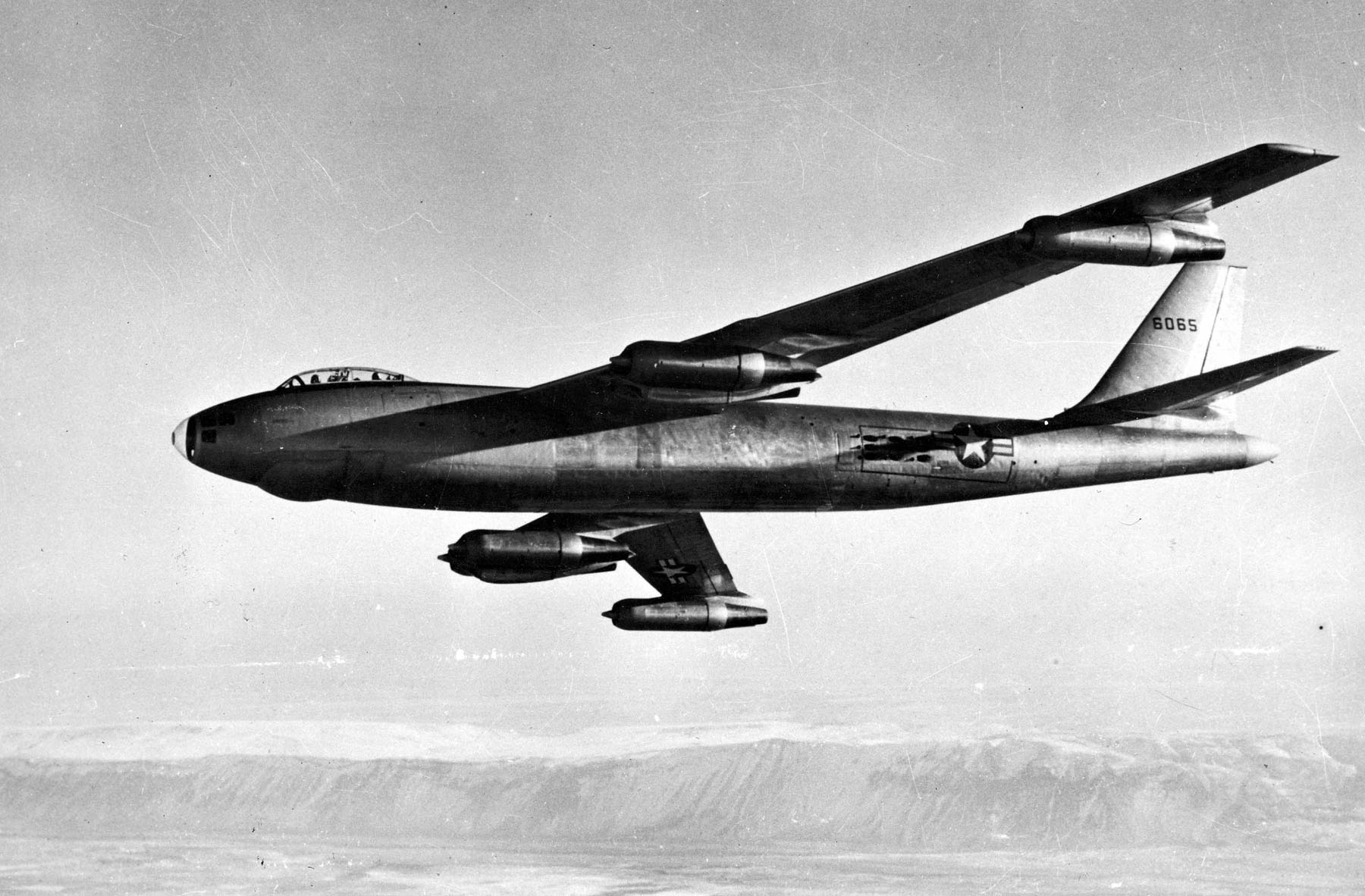
8 February 1949: One of the two Boeing XB-47 Stratojet prototypes made a record-breaking transcontinental flight from Moses Lake Air Force Base, Washington, to Andrews Air Force Base, Maryland, in 3 hours, 46 minutes. The XB-47 departed Moses Lake at 10:22 a.m., Eastern Standard Time (15:22 UTC), and crossed over the Andrews Field control tower at 13,000 feet (3,962 meters) at 2:08 p.m. (19:08 UTC). Majors Russell Ellsworth (“Russ”) Schleeh and Joseph Woodrow Howell beat the official U.S. national record set two years earlier by Colonel William Haldane Councill in a specially-prepared Lockheed P-80A Shooting Star.¹
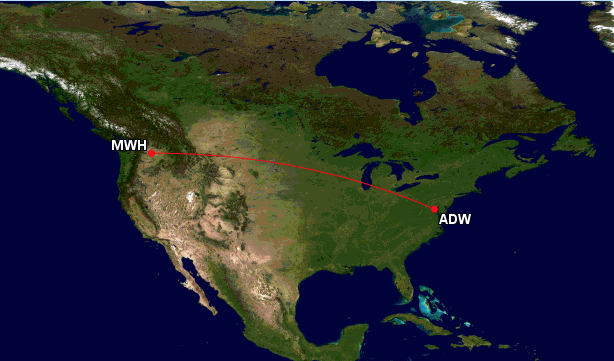
Major Schleeh was the Deputy Chief of Bomber Operations in the Flight Test Division of the Air Material Command, Wright-Patterson Air Force Base, Dayton, Ohio.
The Los Angeles Times reported: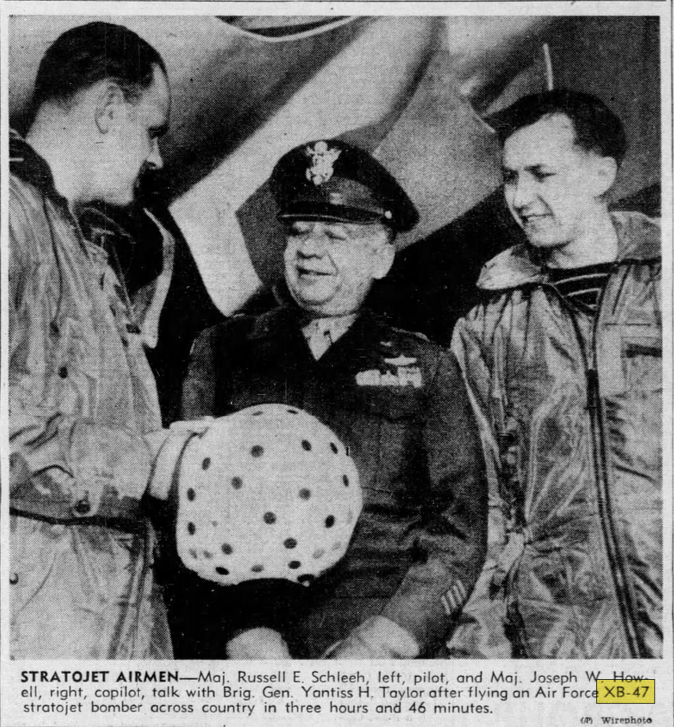
Jet Bomber Spans Nation in 3 Hours 46 Minutes
New Plane Averages 607.2 m.p.h. to Make Fastest Coast-to-Coast Journey on Record
Washington, Feb. 8 (AP)—An arrow-shaped XB-47 jet bomber streaked through the stratosphere at an average speed of 607.2 miles an hour today in the fastest transcontinental flight ever made.
The bomber, rated as “light” despite its 125,000 pounds, flew 2289 miles from Moses Lake (Wash.) Air Base to Andrews Field, Md., a few miles south of the capital, in 3h. 46m.
The pace was 27 minutes shorter in time and 23 miles faster in average speed than the official record of 4h. 13m. at 584 m.p.h. established by Col. William H. Council [sic] in an F-80 Shooting Star two years ago.
No Official Claim
However, the Air Force will claim no record. The flight was not timed officially and it did not fly the recognized contest course. The recognized course—the one Col. Council flew—is Los Angeles to new York, 2464 miles.
The XB-47 is a six-engine, swept wing bomber built by Boeing Airplane Co. at Seattle, known as the Stratojet, it is the Air Force’s first bomber designed for speeds in excess of 600 miles an hour.
The XB-47 is the plane to which Air Force Secretary Symington referred last fall when he mentioned a jet bomber running away from jet fighters. Ten XB-47s are to be built at Boeing’s Wichita (Kan.) plant, where about half of all the B-29s were built during the war.
Maj. Russell E. Schleeh, pilot, and Maj. Joseph W. Howell, co-pilot, both said the flight was strictly routine. They were comfortable in a new type flying suit being tested by the Materiel Command, used oxygen all the way, and navigated by radio compass on a great circle course which took them 20 miles south of Chicago.
The first part of the flight was at 32,000 feet. Later they moved up to 37,000 feet. The pressurized cabin was maintained at 23,000 feet. During one hour they covered 648 miles.
In addition to six J-35 turbo-jet engines built by General Electric Co. at Lynn, Mass., which gave a total of 24,000 pounds of thrust, the Stratojet can use 18 rockets each capable of delivering 1000 pounds of thrust for a few seconds. The rockets were not carried today.
The XB-47 carries a parachute in its tail to help it stop quickly.
—Los Angeles Times, Vol. LXVIII, 9 February 1949, Page 1, Columns 6 and 7, and Page 3, Columns 1–8
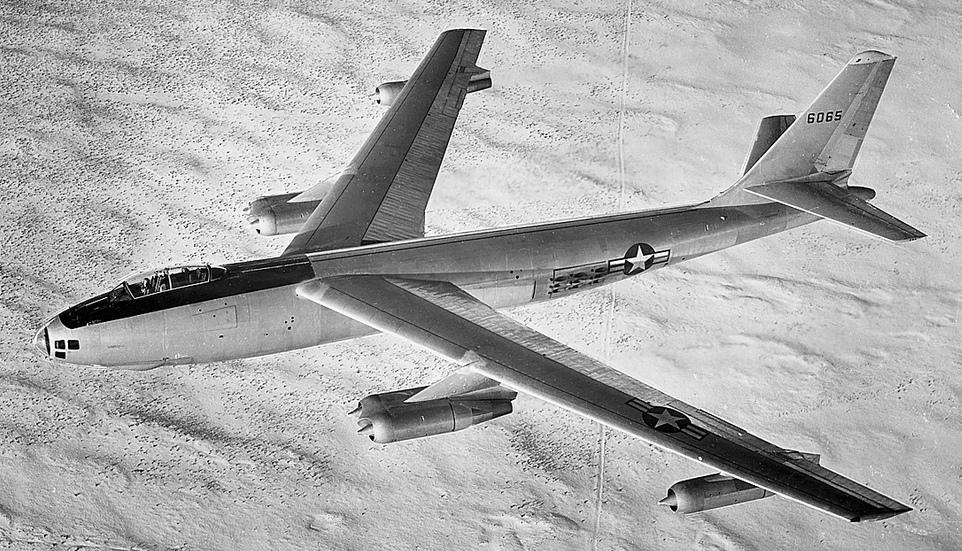
Designed as a strategic bomber, the B-47 could fly higher and faster than jet fighters of the time, and it was also highly maneuverable. The XB-47 (Boeing Model 450) was flown by a two-man crew in a tandem cockpit. It was 107 feet, 6 inches (32.766 meters) long with a wingspan of 116 feet (35.357 meters). The top of the vertical fin was 27 feet, 8 inches (8.433 meters) high. The wings were shoulder-mounted with the leading edges swept at 35°.
The first prototype, 46-065, was powered by six General Electric J35-GE-7 axial flow turbojet engines in four pods mounted on pylons below the wings. The J35 was a single-spool, axial-flow turbojet engine with an 11-stage compressor and single-stage turbine. The J35-GE-7 was rated at 3,750 pounds of thrust (16.68 kilonewtons) at 7,700 r.p.m. (static thrust, Sea Level). The engine was 14 feet, 0.0 inches (4.267 meters) long, 3 feet, 4.0 inches (1.016 meters) in diameter and weighed 2,400 pounds (1,089 kilograms). (The second prototype, 46-066, was completed with J47 engines. 46-065 was later retrofitted with these engines.)
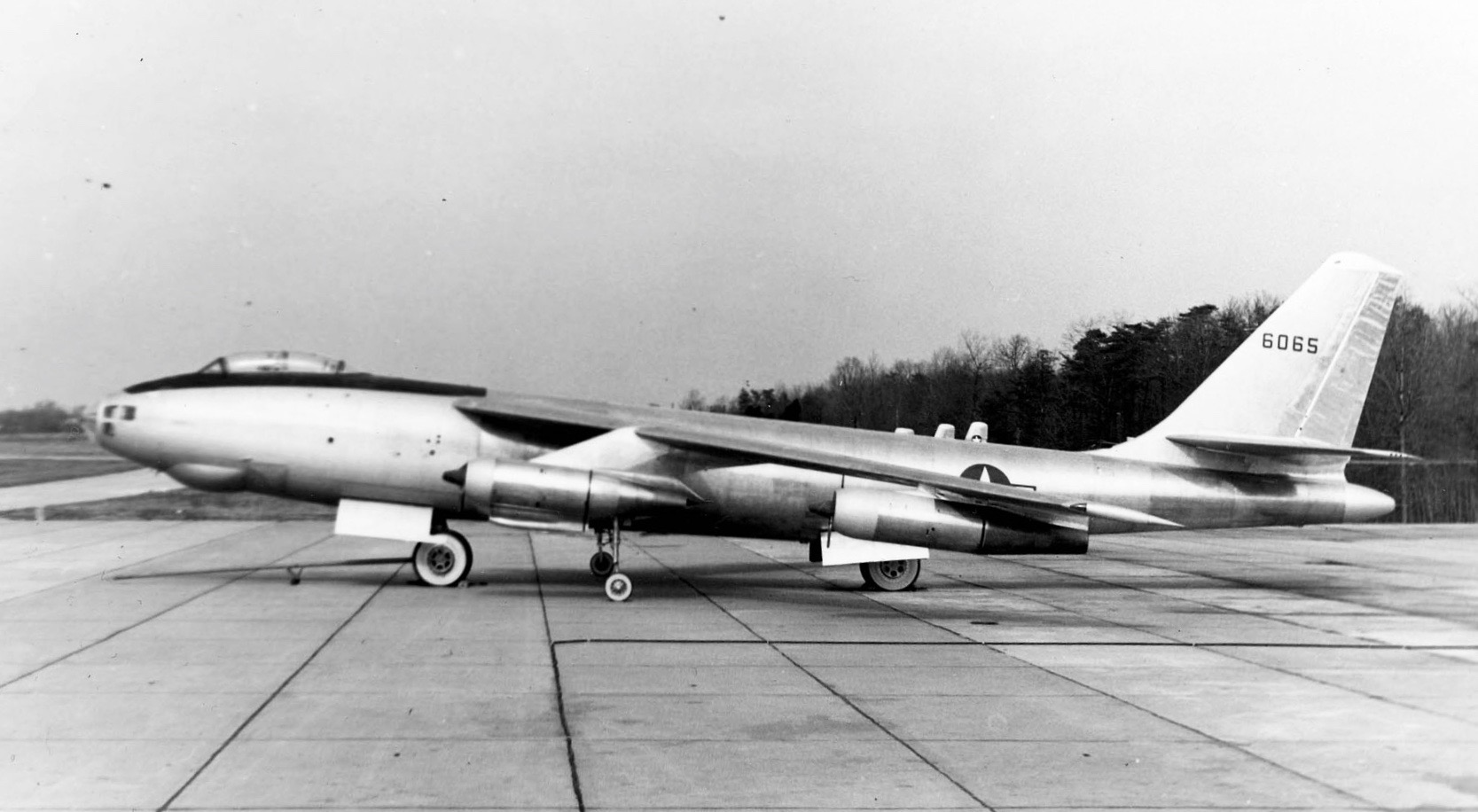
The XB-47 prototype had a maximum speed of 502 knots (578 miles per hour/930 kilometers per hour/0.80 Mach) at 15,000 feet (4,572 meters). The combat speed was 462 knots (532 miles per hour/856 kilometers per hour/0.70 Mach) at 35,000 feet (10,668 meters). The prototype’s empty weight was 74,623 pounds (33,848 kilograms), while its maximum takeoff weight was 162,500 pounds (73,709 kilograms). It required a ground run of 11,900 feet (3,627 meters), or 4,800 feet (1,463 meters) with JATO assist. The bomber could climb at a rate of 3,650 feet per minute (18.5 meters per second) at Sea Level, at combat weight and maximum power. The service ceiling was 37,500 feet (11,430 meters). The XB-47 carried 9,957 gallons (37,691 liters) of fuel. The combat radius was 1,175 nautical miles (1,352 statute miles/2,176 kilometers) with a 10,000 pound (4,536 kilogram) bomb load.
Planned armament (though the XB-47s were delivered without it) consisted of two .50-caliber machine guns in a tail turret, with 1,200 rounds of ammunition, and 10,000 pounds (4,536 kilograms) of bombs.
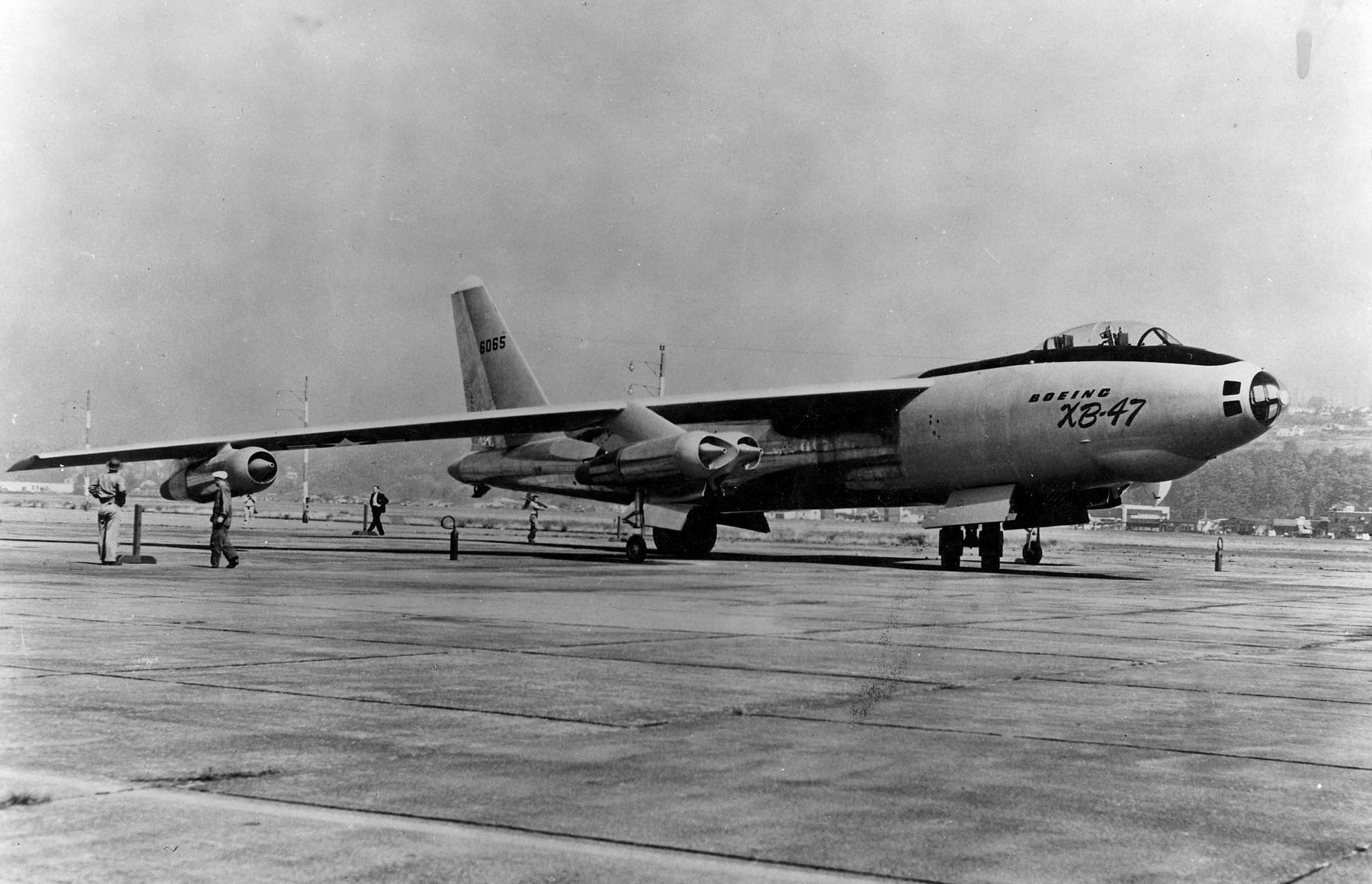
The Stratojet was one of the most influential aircraft designs of all time and its legacy can be seen in almost every jet airliner built since the 1950s: the swept wing with engines suspended on pylons, , mounted forward of the leading edge.
2,032 B-47s were built by Boeing Wichita, Douglas Tulsa and Lockheed Marietta. They served the United States Air Force from 1951 to 1977.
The very last B-47 flight took place 18 June 1986 when B-47E-25-DT, serial number 52-166, was flown from the Naval Air Weapons Center China Lake to Castle Air Force Base to be placed on static display.
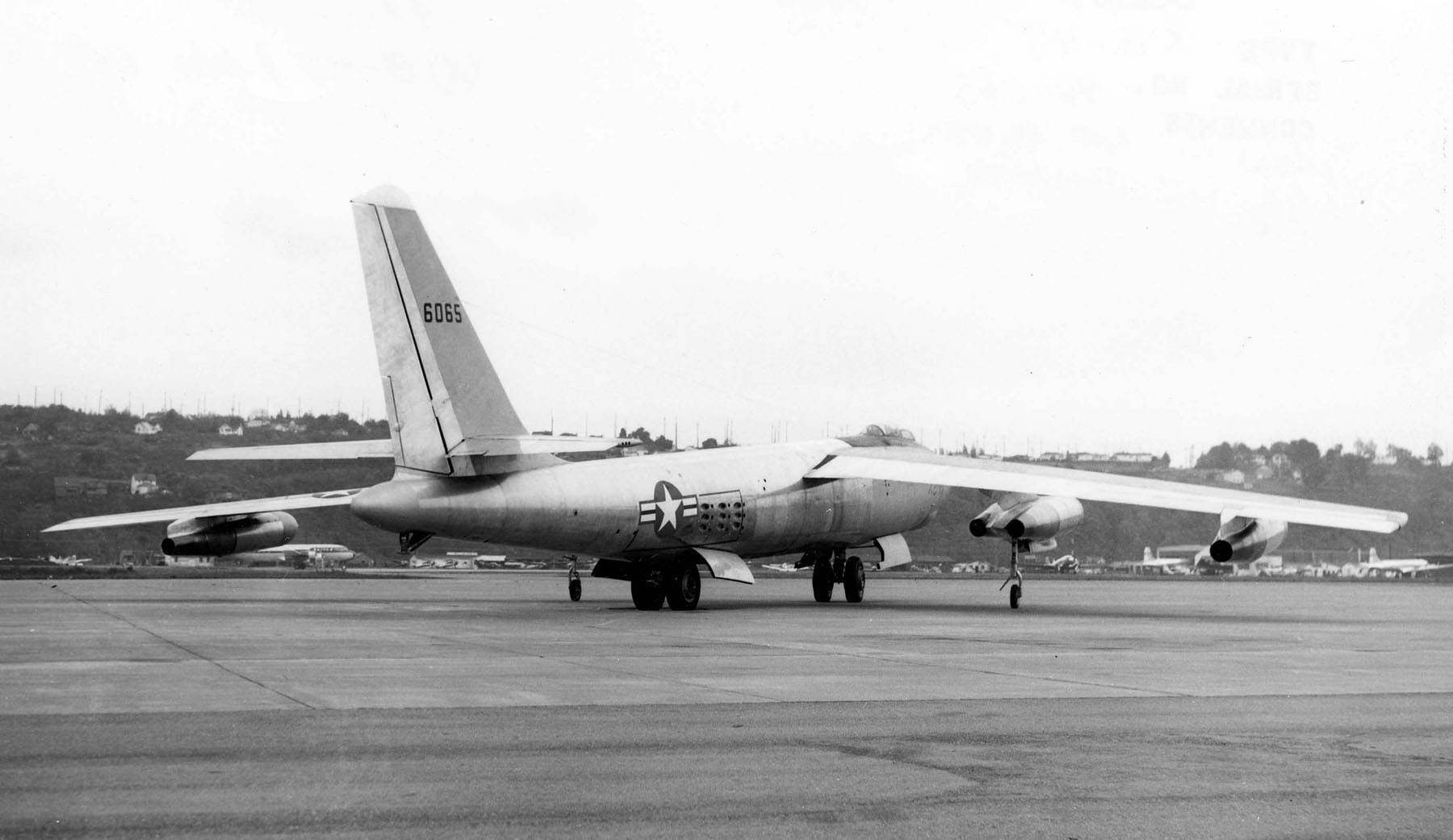
XB-47 45-065 stalled while landing at Larson Air Force Base, near Moses Lake, Washington, 18 August 1951. The crew of three escaped uninjured. The airplane was damaged beyond repair. The second prototype, XB-47 46-066, is in the collection of the Air Force Flight Test Museum, Edwards Air Force Base, California.
¹ See This Day in Aviation for 26 January 1946 at: https://www.thisdayinaviation.com/26-january-1946/
© 2023, Bryan R. Swopes
